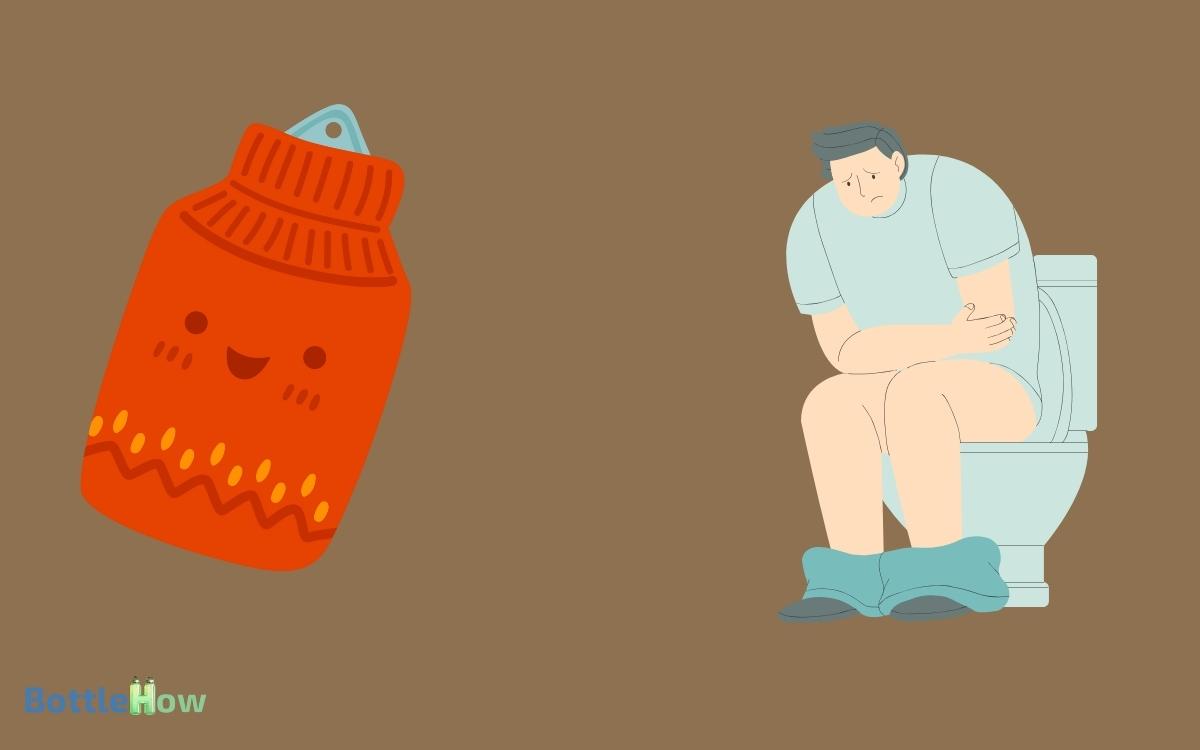Does a Hot Water Bottle Help With Diarrhea? A Guide!
Using a hot water bottle can help alleviate abdominal pain associated with diarrhea. The heat relaxes tight muscles, increases blood flow, and provides quick relief from cramping.
Clinical studies confirm that heat therapy is effective for pain alleviation. Make sure the water’s at a comfortable temperature and wrap the bottle in a towel to prevent burns.
Hydration remains essential, and persistent or severe symptoms warrant consulting a healthcare provider.
For a thorough understanding of managing diarrhea and using hot water bottles safely, there’s more valuable information to explore.

Key Takeaways
Understanding Diarrhea
Diarrhea, characterized by frequent and loose bowel movements, is often caused by infections, dietary habits, or underlying medical conditions.
You should understand that infections from viruses, bacteria, or parasites are common triggers. Dietary factors, like excessive intake of artificial sweeteners or lactose, can also contribute.
Underlying medical conditions such as irritable bowel syndrome (IBS), inflammatory bowel disease (IBD), and celiac disease frequently result in diarrhea. Hydration is essential when experiencing diarrhea to prevent dehydration.
In some cases, medications or medical interventions may be necessary to manage severe symptoms.
You should seek medical advice if diarrhea persists beyond a few days, is accompanied by significant pain, or presents with dehydration signs.
Understanding these causes can help guide effective management strategies.
Common Symptoms
You’ll often notice frequent bowel movements as a primary symptom of diarrhea, typically characterized by loose or watery stools.
Additionally, abdominal pain and cramping are common, stemming from increased intestinal activity.
These symptoms can greatly impact your daily activities and require effective management strategies.
Frequent Bowel Movements
Frequent bowel movements are a hallmark symptom of acute diarrhea, often resulting in significant fluid and electrolyte loss.
When you experience these frequent episodes, your body can quickly become dehydrated, and essential minerals like sodium and potassium may be depleted. This fluid imbalance can lead to further health complications.
To manage frequent bowel movements effectively, consider the following strategies:
- Hydration: Drink oral rehydration solutions to replenish lost fluids and electrolytes.
- Dietary Adjustments: Consume easily digestible foods like bananas, rice, applesauce, and toast (BRAT diet).
- Probiotics: Consider taking probiotic supplements to help restore healthy gut bacteria balance.
Abdominal Pain and Cramping
Experiencing abdominal pain and cramping is a common symptom of diarrhea, often caused by the increased intestinal muscle contractions as your body attempts to expel the irritant.
These symptoms can be both acute and distressing, impacting your daily life and overall well-being.The pain and cramps are typically due to the rapid movement of contents through the intestines.
Here’s a breakdown of common causes and management strategies:
| Cause | Description | Management Strategy |
|---|---|---|
| Infection | Bacterial or viral gastroenteritis | Hydration, rest |
| Food Intolerance | Reaction to certain foods | Avoidance, dietary changes |
| IBS | Irritable Bowel Syndrome | Medications, lifestyle |
| Stress | Emotional distress | Stress management |
| Medication Side Effects | Reaction to certain drugs | Consult healthcare provider |
Traditional Remedies
You might consider incorporating traditional remedies such as herbal teas and infusions, which can soothe the gastrointestinal tract.
Dietary adjustments, like consuming easy-to-digest foods, are also essential in managing diarrhea.
Additionally, hydration techniques, including electrolyte solutions, help prevent dehydration.
Herbal Teas and Infusions
Herbal teas and infusions, such as chamomile and peppermint, have demonstrated efficacy in alleviating gastrointestinal discomfort associated with diarrhea.
These teas can help soothe your digestive system through their anti-inflammatory and antispasmodic properties.
Chamomile contains compounds that reduce inflammation and promote relaxation of the digestive tract. It reduces intestinal inflammation, making it beneficial for gastrointestinal health.
Peppermint is known for its antispasmodic effects, which can ease stomach cramps and reduce bowel movements. Its ability to relax gut muscles can alleviate cramping and pain.
Ginger is another herb that can help in reducing nausea and promoting digestive health through its bioactive compounds. Ginger’s properties make it beneficial for alleviating various gastrointestinal issues.
Dietary Adjustments
Modifying your diet with traditional remedies can greatly alleviate the symptoms of diarrhea and promote gastrointestinal recovery.
Start by incorporating bland, binding foods like bananas, rice, applesauce, and toast (the BRAT diet). These are low in fiber and help firm up your stool.
Avoid dairy products, fatty foods, and high-fiber vegetables, as they can exacerbate symptoms. Incorporate probiotic-rich foods such as yogurt or kefir (if you’re not lactose intolerant) to restore healthy gut flora.
Ginger, known for its anti-inflammatory properties, can soothe your stomach and reduce cramping.
Additionally, consuming small amounts of peppermint tea can relax gastrointestinal muscles and relieve discomfort. Always consult with a healthcare provider to tailor dietary adjustments to your specific needs.
Hydration Techniques
In addressing diarrhea, maintaining proper hydration with traditional remedies is pivotal to replace lost fluids and electrolytes. Effective hydration techniques are essential to prevent dehydration and support recovery.
You should consider these traditional approaches:
- Oral Rehydration Solutions (ORS): Use ORS packets containing a balanced mix of salts and sugars to enhance fluid absorption.
- Herbal Teas: Ginger or chamomile tea can soothe the digestive tract while providing necessary fluids.
- Broths: Clear broths made from vegetables or chicken can help replenish electrolytes and provide easy-to-digest nutrients.
Ensure that you consume these solutions frequently in small amounts. Clinical evidence strongly supports these methods for their effectiveness in managing dehydration associated with diarrhea. Always consult with healthcare professionals for personalized advice.
The Role of Heat
Applying heat from a hot water bottle can help alleviate abdominal discomfort and cramping commonly associated with diarrhea by promoting muscle relaxation and improving blood flow.
Heat therapy works by dilating blood vessels, which increases circulation to the affected area. This enhanced blood flow helps to reduce muscle spasms and decreases the perception of pain.
Additionally, the warmth can stimulate sensory receptors in your skin, providing a soothing counter-stimulation that can help distract from the internal discomfort.
Clinical studies have shown that heat application can be an effective non-pharmacological intervention for gastrointestinal distress.
However, it’s essential to ensure the temperature is moderate to avoid burns or skin irritation. Using a hot water bottle correctly can provide significant symptomatic relief during episodes of diarrhea.
How Hot Water Bottles Work
Understanding the mechanics of how hot water bottles work can further illuminate their efficacy in providing relief from diarrhea-related discomfort.
When you fill a hot water bottle, the heat it generates facilitates vasodilation, which increases blood flow to the targeted area.
This mechanism can alleviate muscle cramps and reduce the perception of pain through the following:
- Thermal Conductivity: The rubber material efficiently transfers heat to your skin.
- Heat Retention: Hot water bottles can maintain a consistent temperature for prolonged periods.
- Tactile Stimulation: The pressure and warmth can activate sensory receptors, providing a soothing effect.
These physiological responses can be critical in easing the abdominal discomfort often associated with diarrhea, offering a non-pharmacological approach to symptom management.
Benefits for Abdominal Pain
You can effectively manage abdominal pain from diarrhea using a hot water bottle. Its heat application eases muscle cramps by increasing blood flow and relaxing tense muscles.
Clinical studies show a significant reduction in discomfort within minutes, providing quick relief.
Eases Muscle Cramps
A hot water bottle can effectively ease muscle cramps, offering significant relief from abdominal pain associated with diarrhea. The heat helps to relax the muscles and improve blood circulation, which can reduce discomfort and promote faster recovery. In addition to soothing cramps, some people find that using a hot water bottle for acid reflux provides temporary relief by relaxing the abdominal area and offering a comforting warmth. However, it should be used alongside other treatments, as heat alone may not address the underlying causes of digestive discomfort.
Applying heat to your abdomen helps relax the muscles in your gastrointestinal tract. This relaxation decreases spasms and discomfort that often accompany diarrhea.
Research underscores the efficacy of heat therapy in relieving muscle cramps by boosting blood flow and reducing muscle tension.
Consider these benefits of using a hot water bottle for muscle cramps:
- Increased blood circulation: Enhances nutrient and oxygen delivery to affected muscles.
- Muscle relaxation: Reduces spasms and tightness in the abdominal area.
- Pain relief: Provides soothing comfort, mitigating the severity of cramps.
Reduces Discomfort Quickly
In addition to easing muscle cramps, a hot water bottle can rapidly reduce abdominal discomfort associated with diarrhea by providing consistent heat that soothes the affected area.
This thermal application works by dilating blood vessels, which improves blood flow and reduces muscle tension.
Clinical evidence suggests that heat therapy can activate heat receptors in the skin, effectively blocking pain signals to the brain.
By placing the hot water bottle on your abdomen, you can experience a swift alleviation of pain and discomfort. It’s a non-invasive, easily accessible method that enhances comfort without the need for medication.
For best results, make sure the water temperature is safe and the bottle is adequately insulated to prevent burns.
Proper Usage Tips
When using a hot water bottle for diarrhea, make sure the water temperature is comfortably warm to avoid skin burns and maximize therapeutic benefits. Proper usage guarantees effectiveness and safety.
Always wrap the hot water bottle in a towel or cloth to prevent direct contact with your skin, which can cause burns. Limit application time to 15-20 minutes per session to avoid prolonged heat exposure.
Here are some additional tips:
- Check for leaks: Verify the hot water bottle is securely sealed to prevent accidental burns.
- Monitor skin condition: Regularly check the skin under the hot water bottle for any signs of redness or irritation.
- Stay hydrated: Use the hot water bottle as an adjunct to other treatments, not a replacement.
These steps will help you use the hot water bottle safely and effectively.
Comparisons to Other Treatments
Comparatively, hot water bottles offer a non-invasive and cost-effective method for alleviating diarrhea-related discomfort, unlike pharmaceutical solutions that may come with side effects.
Applying a hot water bottle to your abdomen can help relax the intestinal muscles, reducing cramping and spasms.
In contrast, over-the-counter antidiarrheal medications, such as loperamide, can cause constipation and other gastrointestinal issues.
Dietary adjustments, like the BRAT diet (bananas, rice, applesauce, toast), also help manage symptoms but lack the immediate soothing effect of heat. Probiotics offer long-term gut health benefits but require time to show results.
While hydration solutions are essential for fluid balance, they don’t directly address discomfort. Incorporating a hot water bottle can provide immediate symptomatic relief alongside other treatments.
Safety Considerations
While hot water bottles can offer immediate relief, it’s important to take into account safety measures to avoid burns or skin irritation.
Make sure the water isn’t boiling and use a cover to provide a protective barrier for your skin. Overheating can cause thermal burns and exacerbate discomfort.
Here are key considerations to keep in mind:
- Temperature Regulation: Always check the temperature before use. Aim for warm, not hot, water.
- Skin Contact Time: Limit direct contact duration to prevent prolonged exposure, which can lead to burns.
- Product Integrity: Regularly inspect the hot water bottle for leaks or wear and tear to prevent accidental burns.
Expert Opinions
Medical experts agree that using a hot water bottle can help alleviate abdominal cramping and discomfort associated with diarrhea, provided it is used with appropriate safety measures.
Heat therapy is known to relax the muscles of your gastrointestinal tract, reducing spasms and pain.
This method is most effective when used as a complementary treatment alongside hydration and dietary adjustments.
| Benefit | Mechanism | Safety Tip |
|---|---|---|
| Muscle Relaxation | Heat relaxes smooth muscle tissue | Don’t apply directly to skin |
| Pain Reduction | Heat increases blood flow | Check temperature frequently |
| Improved Comfort | Provides soothing warmth | Limit use to 20 minutes |
| Reduced Cramping | Eases spasms in GI tract | Use a cover for the bottle |
| Enhanced Relaxation | Promotes overall sense of calm | Monitor for skin irritation |
Using a hot water bottle correctly can notably improve your comfort during episodes of diarrhea.
When to Seek Medical Help
If your diarrhea persists for more than two days, shows signs of dehydration, or is accompanied by severe pain or blood, you should seek medical help immediately.
These symptoms may indicate a more serious underlying condition that requires immediate attention.
Dehydration is a significant concern, especially if you experience:
- Dry mouth and skin
- Dizziness or lightheadedness
- Decreased urine output
Additionally, if you develop a high fever or notice dark or bloody stools, these can be signs of infections or gastrointestinal diseases that need medical evaluation. Persistent diarrhea can lead to severe complications, including electrolyte imbalances.
Consulting with a healthcare professional ensures proper diagnosis and treatment, preventing potential long-term health issues. Don’t hesitate to seek help if symptoms worsen.
Conclusion
In managing the occasional digestive turbulence, a hot water bottle can offer comforting relief. By applying gentle heat, you can soothe abdominal discomfort and promote relaxation.
While it’s no substitute for medical treatment, this traditional remedy can complement other interventions. Always prioritize safety and consult a healthcare professional if symptoms persist.
Embrace this simple, evidence-supported method for a touch of comfort during those less-than-ideal moments.





